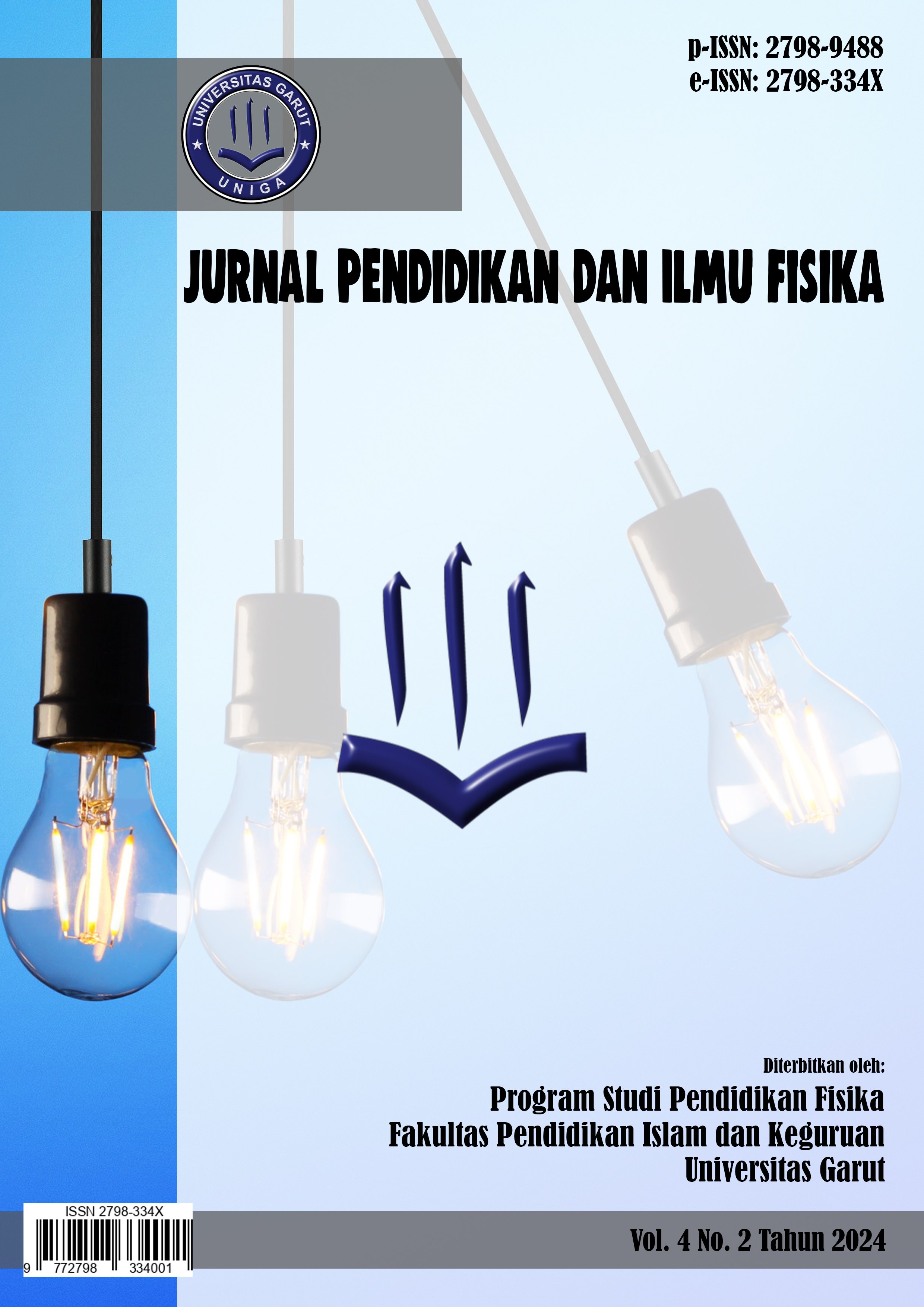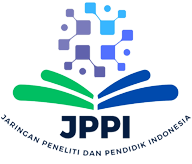Developing Two Tier Multiple Choice Test of Mastery Concept on Heat Material Using Rasch Model
DOI:
https://doi.org/10.52434/jpif.v4i2.41933Keywords:
Concept Mastery, Two Tier Multiple Choice, Heat, Rasch ModelAbstract
One of the objectives of high school physics lessons is to ensure that students master the concepts being taught. For that reason, a test instrument is needed that can accurately measure concept mastery. In this regard, teachers need innovation in the form of developing two-tier multiple choice test instruments. This study aims to evaluate the feasibility of the test instrument on the topic of heat. The method used in this research is research and development (R&D), adapting the instrument development steps using the Rasch model. The developed test instrument consists of 12 items, divided into three categories: 3 items with high difficulty level, 8 items with medium difficulty level, and 1 item with easy difficulty level. Based on the analysis using ministep software version 5.6.4.0, it was found that this test instrument is valid and reliable, with a Cronbach alpha value of 0.71, which falls into the good category, and is able to differentiate students' concept mastery based on high, medium, and low ability levels. This analysis shows that the developed test instrument can be used to measure students' concept mastery ability.
References
Agustianti, R., Abyadati, S., Nussifera, L., Irvani, A. I., Handayani, D. Y., Hamdani, D., & Amarulloh, R. R. (2022). Asesmen dan Evaluasi Pembelajaran. Tohar Media.
Aiken, L. R. (1985). Three coefficients for analyzing the reliability and validity of ratings. Educational and psychological measurement, 45(1), 131–142.
Alfiansyah, A. F., Septianti, R. P., Qolbi, W. N., & Irvani, A. I. (2022). Berkembangnya Pemanfaatan E-Learning pada Proses Pembelajaran Fisika di MAN 1 Garut Selama Masa Pandemi. Jurnal Pendidikan dan Ilmu Fisika, 2(2), 117–124.
Azizah, U., Parno, P., & Supriana, E. (2019). Identifikasi Penguasaan Konsep Fisika Siswa SMA Kelas XI dan XII pada Materi Suhu dan Kalor. State University of Malang.
Azwar, S. (2014). Metode Penelitian, Yogyakarta: Pustaka Pelajar, 2012. Reliabilitas Dan Validitas Edisi, 4.
Bloom, B. (2010). Kerangka Landasan Untuk Pembelajaran, Pengajaran dan Asesmen. Yogyakarta: PustakaBelajar.
Boone, W. J., Staver, J. R., & Yale, M. S. (2013). Rasch analysis in the human sciences. Springer.
Budiyono, A., Wildani, A., & Hair, M. A. (2019). Analisis Peningkatan Penguasaan Konsep Fisika Siswa Melalui Model Learning Cycle 5E Berbantuan Permainan Monopoli Fisika Berpoin (MOKAIN). Seminar Nasional Fisika dan Pembelajarannya, 158–163.
Dharmawati, D., Rahayu, S., & Mahanal, S. (2016). Pengembangan instrumen asesmen berpikir kritis untuk siswa SMP kelas VII pada materi interaksi makhluk hidup dengan lingkungan. State University of Malang.
Dwijayanti, K., & Savitri, E. N. (2022). The development of testlet assessment instrument model integrated with e-ujian website to measure the higher-order thinking skills. Tadris J. Kegur. dan Ilmu Tarb, 7(1), 47–61.
Hasanah, M. (2015). Penerapan Simulasi Komputer Melalui Pembelajaran Kooperatif POE (Predict-Observe-Explain) Untuk Mengurangi Miskonsepsi Dan Meningkatkan Pemahaman Siswa Pada Konsep Suhu Dan Kalor. Universitas Pendidikan Indonesia.
Herman, T., Akbar, A., Farokhah, L., Febriandi, R., Zahrah, R. F., Febriani, W. D., Kurino, Y. D., & Abidin, Z. (2024). Kecakapan Abad 21: Literasi Matematis, Berpikir Matematis, dan Berpikir Komputasi. Indonesia Emas Group.
Heryanto, S. H., Aprianti, S., Pelani, R. R., & Irvani, A. I. (2023). Penggunaan E-learning Madrasah dalam Proses Pembelajaran Fisika di MAN 2 Garut. Jurnal Pendidikan dan Ilmu Fisika, 3(1), 172–178.
Hung, W., & Jonassen, D. H. (2006). Conceptual understanding of causal reasoning in physics. International Journal of Science Education, 28(13), 1601–1621.
Ivanjek, L., Morris, L., Schubatzky, T., Hopf, M., Burde, J.-P., Haagen-Schützenhöfer, C., Dopatka, L., Spatz, V., & Wilhelm, T. (2021). Development of a two-tier instrument on simple electric circuits. Physical Review Physics Education Research, 17(2), 20123.
Jonassen, D. H. (2003). Designing research-based instruction for story problems. Educational Psychology Review, 267–296.
Juhrodin, U. (2023). Taksonomi Anderson (Revisi Atas Taksonomi Bloom). New York: David McKay.
Laksono, P. J. (2018). Pengembangan dan penggunaan instrumen two-tier multiple choice pada materi termokimia untuk mengukur kemampuan berpikir kritis. Orbital: Jurnal Pendidikan Kimia, 2(2), 80–92.
Lengkong, M., Istiyono, E., Rampean, B. A. O., Tumanggor, A. M. R., & Nirmala, M. F. T. (2021). Development of two-tier test instruments to detect student’s physics misconception. 7th International Conference on Research, Implementation, and Education of Mathematics and Sciences (ICRIEMS 2020), 561–566.
Morgil, İ., & Yörük, N. (2006). Cross-age study of the understanding of some concepts in chemistry subjects in science curriculum. Journal of Turkish Science Education, 3(1), 53–65.
Myanda, A. A., Riezky, M. P., & Maridi, M. (2020). Development of two-tier multiple-choice test to assess students’ conceptual understanding on respiratory system material of 11th grade of senior high school. International Journal of Science and Applied Science: Conference Series, 4(1), 44–55.
Nahadi, N., Siswaningsih, W., & Purnamasari, R. (2014). Pengembangan tes diagnostik two-tier dan manfaatnya dalam mengukur konsepsi kimia siswa sma. Jurnal Penelitian Pendidikan Kimia: Kajian Hasil Penelitian Pendidikan Kimia, 1(1), 51–58.
Ocy, D. R., Rahayu, W., & Makmuri, M. (2023). RASCH MODEL ANALYSIS: DEVELOPMENT OF HOTS-BASED MATHEMATICAL ABSTRACTION ABILITY INSTRUMENT ACCORDING TO RIAU ISLANDS CULTURE. AKSIOMA: Jurnal Program Studi Pendidikan Matematika, 12(4), 3542–3560.
Paling, S., Makmur, A., Albar, M., Susetyo, A. M., Putra, Y. W. S., Rajiman, W., Djamilah, S., Suhendi, H. Y., & Irvani, A. I. (2024). Media Pembelajaran Digital. TOHAR MEDIA.
Planinic, M., Boone, W. J., Susac, A., & Ivanjek, L. (2019). Rasch analysis in physics education research: Why measurement matters. Physical Review Physics Education Research, 15(2), 20111.
Qi, S., & Mitchell, R. E. (2012). Large-scale academic achievement testing of deaf and hard-of-hearing students: Past, present, and future. Journal of deaf studies and deaf education, 17(1), 1–18.
Rawzis, K., Irvani, A. I., Elviana, T., Abe, Y., & Chatimah, H. (2024). A Decade of Bibliometrics Exploration on Wind Tunnel as Learning Media in Fluid Mechanics. Tarbiyah Suska Conference Series, 3(1), 86–103.
Retnawati, H. (2016). Analisis kuantitatif instrumen penelitian (panduan peneliti, mahasiswa, dan psikometrian). Parama publishing.
Suharsimi, A. (2006). Prosedur penelitian suatu pendekatan praktik. Jakarta: Rineka Cipta, 134, 252.
Sumintono, B. (2018). Rasch model measurements as tools in assesment for learning. 1st International Conference on Education Innovation (ICEI 2017), 38–42.
Sumintono, B., & Widhiarso, W. (2015). Aplikasi pemodelan rasch pada assessment pendidikan. Trim komunikata.
Syahdah, V. S., & Irvani, A. I. (2023). Kesulitan Menanamkan Jiwa Percaya Diri terhadap Kemampuan Mengerjakan Soal Fisika. Jurnal Pendidikan dan Ilmu Fisika, 3(1), 163–171.
Tan, K. C. D., & Treagust, D. F. (1999). Evaluating students’ understanding of chemical bonding.
Thomaz, M. F., Malaquias, I. M., Valente, M. C., & Antunes, M. J. (1995). An attempt to overcome alternative conceptions related to heat and temperature. Physics Education, 30(1), 19.
Tuysuz, C. (2009). Development of two-tier diagnostic instrument and assess students’ understanding in chemistry. Scientific Research and Essay, 4(6), 626–631.
Van Heuvelen, A. (1991). Learning to think like a physicist: A review of research‐based instructional strategies. American Journal of physics, 59(10), 891–897.
Widhiarso, W. (2016). Penerapan model Rasch untuk mengevaluasi tes UKKS dan UKPS. Tenaga Kependidikan, 1(1), 50–51.
Wilson, L. O. (2016). Anderson and Krathwohl–Bloom’s taxonomy revised. Understanding the new version of Bloom’s taxonomy.
Downloads
Published
Issue
Section
License
Copyright (c) 2024 Novia Ananda Putri, Winny Liliawati, Ridwan Efendi

This work is licensed under a Creative Commons Attribution 4.0 International License.

























